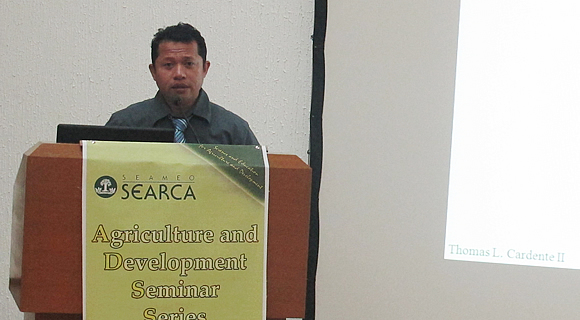
Spiked pepper tree (Piper aduncum), although considered an invasive species in some forest areas in Mindanao, can be economically beneficial once it is managed effectively. This was revealed by Dr. Thomas L. Cardente II in his presentation entitled “A Management System for Watersheds Dominated by Spiked Pepper (Piper aduncum) in Southern Mindanao, Philippines.” Cardente served as resource speaker for SEARCA’s Agriculture and Development Seminar Series on 18 September 2012.
Locally known as boyo-boyo, spiked pepper tree has become dominant vegetation in rocky and former cogon and hagonoy sites in Southern Mindanao. The species is known to be native to tropical America and has been introduced in the Philippines, particularly in Western Mindanao through bird migration. Despite its now ubiquitous presence in the south of the country, the very little information available on spiked pepper tree has prompted Cardente to study the species, particularly its potential in reforestation and watershed management.
According to Cardente, instead of removing the invasive spiked pepper tree, it can become a strong tool in protecting reforestation areas and hilly lands particularly from massive erosion during rainy season and threat of wildfires during prolonged droughts. As it deposes the huge swaths of cogon and other fire-prone and less-useful grasses and weeds, boyo-boyo can improve the micro-climate in the area, and in general mitigate climate change.
Aside from its ecological benefits, spiked pepper tree can become a sustainable livelihood option for the upland dwellers. The mature spiked pepper is best used for fuelwood and charcoal production, making it a sustainable alternative for the more valuable indigenous species in the forest. It can also serve as building materials, with its lumber used for roof construction. In fact, the upland dwellers have not considered boyo-boyo as nuisance in farmed areas. It can serve, among others as organic fertilizer and herbicide, stakes of tomato and asparagus plantations, fence, rafters and poles for houses, shade for livestock.
While in general, the study showed that the advantages of spiked pepper tree outweigh its disadvantages, Cardente recommended managing the species on areas where it is abundant. Introducing the said tree in other areas as a strategy for reforestation may have to be studied further.
Cardente is a Forester I at the Department of Environment and Natural Resource Region 12. He completed his PhD in Forest Resource Management at UP Los Baños in October 2011, with his dissertation supported by SEARCA through its PhD Research Scholarship Grant.